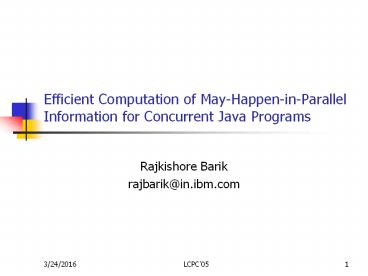Efficient Computation of May-Happen-in-Parallel Information for Concurrent Java Programs - PowerPoint PPT Presentation
Title:
Efficient Computation of May-Happen-in-Parallel Information for Concurrent Java Programs
Description:
Efficient Computation of May-Happen-in-Parallel Information for Concurrent Java Programs ... statements that may execute in parallel in a multithreaded program ... – PowerPoint PPT presentation
Number of Views:18
Avg rating:3.0/5.0
Title: Efficient Computation of May-Happen-in-Parallel Information for Concurrent Java Programs
1
Efficient Computation of May-Happen-in-Parallel
Information for Concurrent Java Programs
- Rajkishore Barik
- rajbarik_at_in.ibm.com
2
Introduction
- May-happen-in-parallel (MHP) analysis
- Statically determines statements that may
execute in parallel in a multithreaded program - Application
- Detecting synchronization anomalies
- Program optimization
- Debuggers and program understanding tools
- Data flow analysis
- Enforce ordering among shared accesses
- Complexity
- NP-complete (Taylor)
3
Related Work
- B4 analysis (Callahan and Subhlok)
- Ada
- Interprocedural B4 analysis (Duesterwald and
Soffa) - Non-concurrency analysis (Masticola and Ryder)
- May-Happen-in-Parallel analysis (Naumovich and
Avrunin) - Java
- May-Happen-in-Parallel analysis (Naumovich and
Avrunin) - Data flow analysis
- Constructs start, join, notify, wait, notifyAll,
locks - Number of runtime threads need to be explicitly
enumerated during static analysis - Worst-case complexity (pN)3 where p is the
number of runtime threads and N is the number of
PEG nodes per thread - Happens-before, happens-after and
happens-in-parallel (Sura et al.) - Data flow analysis
- Constructs start, join, locks
4
Example
- 1 class Shared int field0
- 2 class Main
- 3 static Shared s
- 4 public static void main(String args)
- 5 s new Shared()
- 6 s.field
- 7 Thread ta new Thread10
- 8 for(int i0ilt10i)
- 9 tai new Task1()
- 10 tai.start()
- 11
- 12 s.field
- 13 Thread t2 new Task1()
- 14 t2.start()
- 15 s.field
- 16
- 17
- 18 class Task1 extends Thread
5
Thread Model
- Abstract Thread (ti)
- Compile-time entity that corresponds to
invocation of Threadstart in a context - isUniqueti holds if ti has unique runtime
correspondence - Intra-thread control flow graph,
- ICFG(ti) ltV(ti), E(ti)gt
- V(ti) USE(ti) 4 ASS(ti) 4 NEW(ti)
- 4 BEGIN(ti) 4 END(ti ) 4 ENTRY(ti )
- 4 EXIT(ti) 4 CSTART(ti) 4 CJOIN(ti)
- 4 CALL(ti) 4 ACQUIRE(ti) 4 RELEASE(ti)
- E(ti) contains both intra and inter procedural
control flow edges - locksvi denotes the set of objects that are
locked while executing vi cV(ti)
6
Program Representation
- Must-join abstract thread (tj)
- CJOIN(ti,tj) postdom CSTART(tk,tj) and ti tk
- Thread Creation Tree (TCT)
- Encodes start relationship among abstract threads
- Nodes are abstract threads Edges represent
thread creation - Nodes in TCT are colored black if it is not a
must-join abstract thread - yca(ti,tj) denotes the youngest common ancestor
of ti and tj in TCT - canc(ti,tj) denotes the child of ti that is an
ancestor of tj
7
MHP Computation
- MHP Computation
- Thread-level MHP (Èt)
- Node-level MHP (Èn)
- Thread-level MHP
- ti Èt tj true, if ti c anc(tj ) or tj c
anc(ti )
8
MHP Computation
9
MHP Computation
10
MHP Computation
11
MHP Computation
- Node-level MHP
12
MHP Computation
13
MHP Computation
14
MHP Computation
15
MHP Computation Algorithm
- 1. Identify abstract threads and their ICFGs.
- 2. for every abstract thread ti do
- 3. Compute postdom for every node in Vi.
- 4. Compute reachability information.
- 5. for every child abstract thread tj of ti do
- 6. Compute start-dominance information w.r.to
tj. - 7. end for
- 8. Add a node to TCT.
- 9. end for
- 10. Compute must-join chains and yca information.
- 11. for all abstract thread ti do
- 12 for all abstract thread tj do
- 13 for all vim cVi do
- 14 for all vjn cVj do
- 15 Determine vim Èvjn
- 16 end for
- 17 end for
- 18 end for
- 19 end for
16
Complexity
- Worst-case complexity is (kN)2, where
- k is the number of abstract threads and
- N is the number of ICFG nodes per thread
17
Experimental Setup
- Infrastructure
- ERCO (ETH Research COmpiler at ETH, Zurich)
- Pentium IV at 2.66GHz on RedHat Linux
- Benchmarks
- Java Grande Forum
- Philo, tsp, elevator, sor and mtrt
- Comparison
- Naumovich et al, our approach
18
Experimental Results
19
Experimental Results
20
Conclusion
- A new thread model based on context and flow
sensitive analysis is presented. - MHP computation is split into thread-level and
node-level based on TCT and is obtained
efficiently. - TCT depicts interaction among threads and can
perform various thread structure analysis. - Our MHP algorithm is on an average 1.77x faster
than Naumovich et al.































